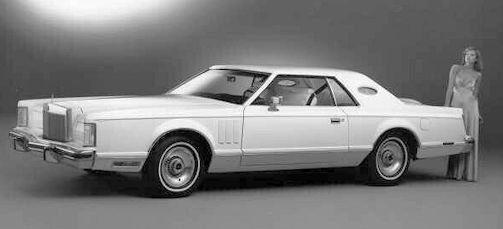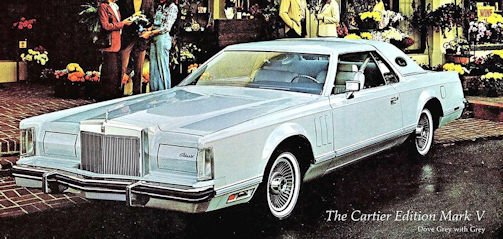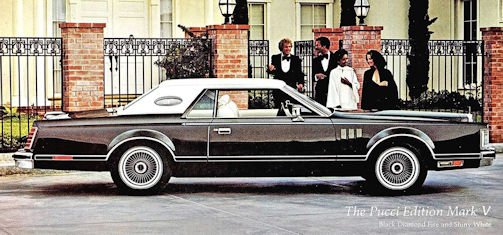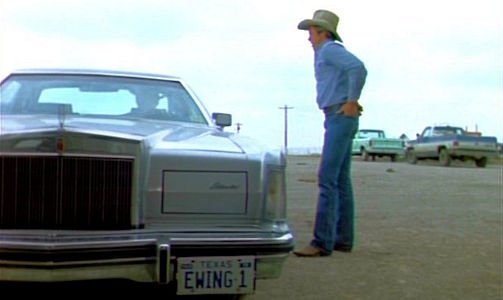Lincoln Continental Mark V
 |
|
|
Manufacturer |
Lincoln (Ford Motor Company) |
|
Model years |
1977 to 1979 |
|
Assembly |
United States |
|
Designer |
Gene Borndinat |
|
Class |
luxury car |
|
Body style |
2-door coupe |
|
Layout |
FR layout |
|
Engine |
400 cu in (6.6 L) 335 Series V8 |
|
Transmission |
three-speed C6 automatic |
|
Wheelbase |
120.4 in (3,058 mm) |
|
Length |
230.3 in (5,850 mm) |
|
Width |
79.7 in (2,024 mm) |
|
Height |
52.9 in (1,344 mm) |
|
Curb weight |
4,762–4,960 lb (2,160–2,250 kg) |
|
Chronology |
|
|
Predecessor |
Continental Mark IV |
|
Successor |
Continental Mark VI |
The Continental Mark V was a full-size vehicle of the American automaker Ford Motor Company, which was produced from 1977 to 1979. He was the third generation of a series founded in 1968 with the Continental Mark III luxury models, which until 1983 as the Continental Mark Series and since then as Lincoln Mark Series is called and which was positioned above the Lincoln brand. The Mark V sold very well despite its size in the late 1970s. It was the most successful model in the entire Mark Series.
Manufacturer of the Continental Mark V was the Lincoln-Mercury Division of the Ford Motor Company. As with its predecessors Mark III and Mark IV, the Mark V was also officially marketed as Continental Mark V. With this model, Ford built on the tradition of the Continental Division, which was an independent subsidiary from 1956 to 1960 and produced high-quality luxury vehicles, including a Continental Mark V (1960), offered in various body shapes. The reference to the Continental Division was made for marketing purposes to document the exclusivity of the Mark V. n the literature, accordingly, usually only the models of the vintages from 1956 to 1960 and 1969 to 1983 listed as Continentals, while the new, 1983 launched Mark Series is assigned to the Lincoln.
There is cause for misunderstanding in so far as Lincoln used the term Continental (without the suffix "Mark") since 1961 additionally as a pure model name for his models. These vehicles, which were positioned below the Continental Mark series, were given the brand name Lincoln and were called Lincoln Continental. Technically (except in the case of the later Mark VI) they had nothing to do with the Continental Mark models.
History
The Continental Mark V was not completely redeveloped. Lincoln took over the chassis and the entire drive technology from its predecessor, the Mark IV. New were only the body and the interior.
With the Mark V separated so far parallel development of the Mark Series of the Ford Thunderbird. The Thunderbird was completely redesigned for the model year 1977 and fell, since he was now based on the technology of the mid-size model Ford LTD II, significantly smaller. Regardless of the austerity that resulted for all American automakers from the first oil crisis, Lincoln did not implement this reduction for his top model, to externally document the membership of the model to the upper class.
In fact, the Mark V was the only newly introduced American car of the late 1970s, which was (still) larger than its predecessor: The length of the coupe grew over the Mark IV at the same wheelbase by seven inches, the width of 1.5 centimetres, The space in the interior grew; at the same time the trunk was increased by 21 percent. Critical voices indicated that such a high rate of increase was only achieved because the initial value of the Mark IV had been so low. However, the engineers to reduce the weight of the Mark V by almost 400 kg.
From a stylistic point of view, the Mark V turned out fundamentally unchanged design significantly more angular than its predecessor. The body showed almost no curves. The Mark V sported the signature features of the Mark Series: a Rolls-Royce radiator grille, pop-up headlamps, an imitation spare wheel cover on the boot lid, and the Opera Window, an oval window in the C-pillar. New were three vents ("Louvres") in the front fenders, which actually did not fulfil any function and were primarily a gimmick of the designers.
The drive was a standard 6.6-liter eight-cylinder engine, 1977 179 hp (132 kW), 1978 166 hp (122 kW) and 1979 159 hp (117 kW) made. Equipped with a simple double carburettor engine met the strict emission regulations California. In all states except California in 1977 and 1978, alternatively, the 7.5 -Liter eight-cylinder engine was available, which had been the standard engine since the Mark III. He made 208 hp (153 kW).
According to factory specifications, the consumption of the Mark V was 19 litres of regular gasoline per 100 kilometres. The trade magazine auto motor und sport published in 1979 a test report entitled "The last dinosaur" about the Mark V with 7.5-liter V8 engine and determined a test consumption of 33.3 litres per 100 km. However, in the test, the air conditioner ran full force despite the windows open, and the car was moved at high speed in second gear.
The Mark V was neither technically nor stylistically revised in its three-year construction period. The individual model years differ mainly by the composition of the interior design of each other.
Distribution
The Mark V was the most successful model in the Mark Series. 1977 sold Ford 80,321 copies, 1978 there were 72,602 and 1979 - at the height of the second oil crisis - another 75,939 vehicles.
Designer Series and Special Series

The Mark V took over the concept introduced in its predecessor in 1976 of special designer series. In addition, the Diamond Jubilee Edition (1978) and the Collector's Series (1979) were offered as special series.
The Designer Series were special outfits of the Mark V, which were associated with the names of certain fashion designers or jewellers. The idea of a special designer variant goes back to the American Motors Corporation, which introduced a Hornet "Gucci" in 1971. Lincoln offered from 1977 to 1979 Mark V versions of Bill Blass, Cartier, Hubert de Givenchy and Emilio Pucci on. The versions each had their own paint and a special interior and differed from year to year.
|
model year |
Bill Blass |
Cartier |
Givenchy |
Pucci |
|
1977 |
Lacquered dark blue, |
Painting dove Gray |
Dark green ("jade") finish including C-pillar |
Painted black |
|
1978 |
Lacquered dark brown ("Cordovan") |
Lacquer, vinyl roof and interior cream-colored ("Champagne") |
Dark green ("jade") finish including C-pillar |
Painting silver metallic |
|
1979 |
Two-tone paintwork: lower car part blue, upper white |
Lacquer, vinyl roof and interior cream-colored ("Champagne") |
Paint, vinyl roof and interior in different shades of dark blue |
Varnishing turquoise |

Diamond Jubilee Edition (1978)
The 75th anniversary of the Ford Motor Company in 1978 was the occasion for both the Ford Thunderbird and the Lincoln Continental Mark V a Diamond Jubilee Edition together. There were two alternative colour schemes for the Mark V:
- Jubilee Gold: paint, vinyl roof, rims and struts of the radiator grille in gold metallic, interior cream-colored.
- Diamond Blue: paint, vinyl roof and interior in different light blue tones.
The vehicles were fully equipped and got beyond the regular accessories addition to some other features such as a vinyl cover for the (imitated) spare wheel cover on the boot lid, a leather-clad dashboard or car key with wood inserts in the grip area.
The retail price for the Diamond Jubilee Edition vehicles in 1978 was $ 20,529. The Anniversary model was $ 8,000 (or the equivalent of two Ford Fairmont mid-range models) more expensive than a regular Mark V. Lincoln sold a total of 5,159 Diamond Jubilee Editions in 1978.
Collector's Series (1979)
In 1979, the last model year of the Mark V, Lincoln put on a Collector's Series, with which the farewell to the full-size models should be committed. The Collector's Series reverted to many of the features of last year's Diamond Jubilee Edition, including the vinyl cover on the boot lid and the wooden inserts for the keys. The model was available in four colours (light blue, dark blue, white and silver). A special feature was that it had no Opera Windows. The purchase price of the Collector's Series was $ 20,926 (with leather upholstery) or $ 21,326 (with velour interior). In 1979, 6,262 copies of the Collector's Series were sold.
Trivia
In the TV series Dallas, a 1978 model of the Mark V was very common, which was driven by Jim Davis in the role of Jock Ewing. In the TV series Supernatural, the angel Castiel drives a golden Continental in the Jubilee Edition.

